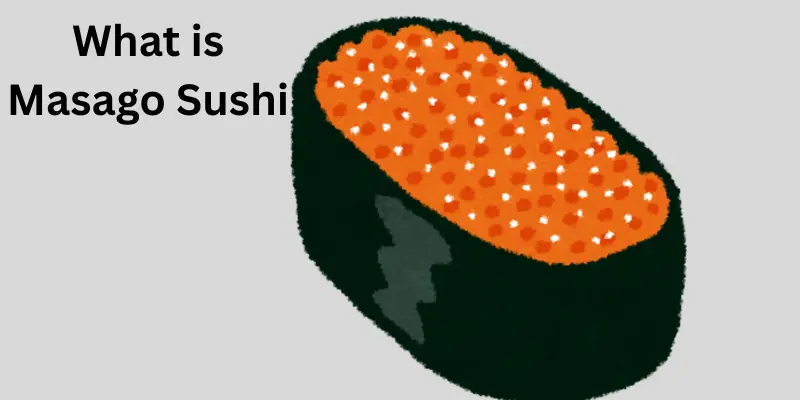What Is Masago Sushi? Flavor, Nutrition, and Why It’s So Popular
Published: 22 Sep 2025
Masago is the bright orange base that makes rolls an attractive and fresh look. Tiny fish eggs provide a crunchy texture and a salty taste. Chefs like to use it because it gives both flavor and beauty to every sushi roll. You may have noticed masago sushi covering over California rolls or glowing on top of nigiri.
This small ingredient has more than just a beautiful role. Masago sushi has a story, a unique flavor, and an important role in Japanese cuisine. People throughout the world like it, but they have no idea what it is. But what makes masago sushi special? Let us find out.
What Is Masago Sushi?
Masago sushi is sushi made with small orange fish eggs called masago. These eggs come from a fish called capelin. They are tiny, soft, and full of taste. When added to sushi, they give a light crunch and a salty taste.

Masago is like other fish eggs, but it is special. Tobiko, also known as flying fish roe, is larger and crunchier. Ikura, or salmon roe, is much bigger and has a strong taste. Masago is smaller, softer, and milder, making it easier to eat.
The History and Origin of Masago
Masago has a long place in Japanese food tradition. In Japan, people have eaten fish of sushi roe for many years. It was seen as a food that showed richness and good health. Chefs used it to add both flavor and beauty to their dishes.
Over time, masago became popular outside Japan. Sushi restaurants around the world started using it because it was tasty, colorful, and affordable. Today, masago sushi is enjoyed by people everywhere as a symbol of Japanese eating culture.
Taste and Texture of Masago
Masago has a natural, slightly salty flavor with an element of sweetness. The eggs are little and soft, but they always provide a slight crunch when eaten. The mix of flavor and texture makes masago sushi delicious and special.
Chefs often use masago as a garnish. The bright orange color makes sushi look fresh and attractive. It also gives another level of flavor without overpowering the fish or rice. Masago is smaller, softer, and less crunchy compared to tobiko, and is known as flying fish roe. Tobiko has a stronger taste than masago, but is more delicate.
How Masago Is Used in Sushi
Masago is used in many types of ways to increase the color and flavor of sushi. Chefs often sprinkle it on top of rolls like California rolls and Dragon rolls. It provides the sushi a beautiful color and little crunch.
Masago is also used in gunkan maki, a dish in which eggs are served on top of seaweed-wrapped rice. Some chefs use it with sauces to increase the flavor for spicy rolls. It may also be used to poke bowls and salads for extra taste and texture.
Nutritional Benefits of Masago
Masago sushi is not only tasty but also healthy. These tiny fish eggs are full of nutrients that your body needs.
- Rich in omega-3 fatty acids for heart health
- Good source of protein for energy
- Contains vitamins and minerals like B12 and selenium
- Low in calories but packed with nutrition
Masago vs. Other Types of Roe
Masago is often compared with other kinds of fish roe. Each type has its own color, taste, and texture that make it unique.
Masago vs. Tobiko
Masago eggs are smaller and softer, while tobiko eggs are bigger and crunchier. Tobiko is also brighter in color and has a stronger taste. Masago is milder and easier to use in many sushi rolls.
Masago vs. Ikura
Ikura is salmon roe and looks very different from masago. Ikura eggs are much larger, juicy, and have a rich, salty flavor. Masago, on the other hand, is tiny, soft, and has a lighter taste that blends well with rice.
Masago vs. Caviar
Caviar is made from sturgeon eggs and is known as a luxury food. It has a deep flavor and is very expensive. Masago is more affordable and is a common sushi topping, loved for its bright color and crunchy bite.
How to Eat Masago at Home
Masago sushi can be enjoyed at home if you know how to handle it. Buying, storing, and using it the right way keeps it fresh and tasty.
Tips for buying fresh masago
Look for bright orange eggs with no strong smell. Buy from trusted Japanese stores or seafood markets. Frozen masago is also common and safe to use.
How to store it properly
Keep masago frozen until you are ready to use it. Once thawed, store it in the fridge and eat it within 2–3 days. Do not refreeze after thawing.
Quick recipes
- Add masago to homemade sushi rolls for extra crunch.
- Mix into poke bowls with rice, fish, and veggies.
- Blend with mayonnaise or cream cheese to make a dip.
Where to Buy Masago
Masago sushi is easy to find if you know where to look. It is sold in many Japanese supermarkets, local fish markets, and even online food stores. Frozen packs are the most common, and they are usually ready to use after thawing.
Storage and Freezing Tips
- Keep masago frozen until you are ready to use it.
- Store opened masago in an airtight container in the fridge.
- Eat within 2–3 days after thawing for the best flavor.
- Never refreeze masago once it has been thawed.
Fun Facts About Masago
Masago sushi has some fun secrets that many people don’t know. These little eggs are more than just a topping—they carry a lot of surprises.
- Masago is sometimes dyed to look brighter, often to match the color of tobiko.
- Many sushi chefs use masago as a secret trick to add extra crunch to rolls.
- It is not only used in traditional sushi but also in fusion dishes like sushi tacos and sushi burritos.
Conclusion
Masago sushi is not only a garnish. Every sushi roll is made interesting by its bright color, light crunch, and salty flavor. It also provides health benefits like protein and omega-3, making it both delicious and healthy.
Masago has become a popular sushi dish all over the world, especially in Japan. It is affordable, easy to use, and full of taste. Next time you eat sushi, try masago and enjoy the unique taste that it gives to every bite.
FAQs
Masago and caviar are both fish eggs, but they are different. Masago comes from capelin, while caviar comes from sturgeon. Caviar is more expensive and richer in taste.
Masago itself is not spicy. Sometimes chefs mix it with wasabi or sauces to make it spicy.
Yes, masago is healthy in small amounts. It has protein, omega-3, and vitamins but is also high in sodium.
No, masago is not very expensive. It is cheaper than tobiko and caviar, which makes it popular in sushi.
Bluefin tuna is one of the most expensive seafood in the world. It is often sold at very high prices in Japan.
Eat it in one bite to enjoy the flavor and texture together. Use soy sauce lightly so the eggs don’t fall off.
Tobiko is fish roe, so it can be halal if sourced from fish allowed in Islam. However, always check if it was processed with alcohol or additives.

- Be Respectful
- Stay Relevant
- Stay Positive
- True Feedback
- Encourage Discussion
- Avoid Spamming
- No Fake News
- Don't Copy-Paste
- No Personal Attacks

- Be Respectful
- Stay Relevant
- Stay Positive
- True Feedback
- Encourage Discussion
- Avoid Spamming
- No Fake News
- Don't Copy-Paste
- No Personal Attacks





